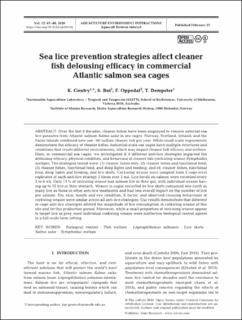| dc.description.abstract | Over the last 2 decades, cleaner fishes have been employed to remove external sea lice parasites from Atlantic salmon Salmo salar in sea cages. Norway, Scotland, Ireland, and the Faroe Islands combined now use ~60 million cleaner fish per year. While small-scale experiments demonstrate the efficacy of cleaner fishes, industrial-scale sea cages have multiple structures and conditions that create different environments, which may impact cleaner fish efficacy and welfare. Here, in commercial sea cages, we investigated if 4 different anti-lice strategies impacted the delousing efficacy, physical condition, and behaviour of cleaner fish (corkwing wrasse Symphodus melops). The strategies tested were: (1) cleaner fishes only; (2) cleaner fishes and functional feed; (3) cleaner fishes, functional feed, and deep lights and feeding; and (4) cleaner fishes, functional feed, deep lights and feeding, and lice skirts. Corkwing wrasse were sampled from 3 cage-level replicates of each anti-lice strategy 3 times over 2 mo. Lice levels on salmon were recorded every 3 to 4 wk. Only 11% of corkwing wrasse had salmon lice in their gut, with individual wrasse having up to 72 lice in their stomach. Wrasse in cages encircled by lice skirts consumed one-ninth as many lice as those in other anti-lice treatments and had less overall impact on the number of lice per salmon. Fin, skin, mouth and eye condition, K factor, and observed cleaning behaviours of corkwing wrasse were similar across all anti-lice strategies. Our results demonstrate that different in-cage anti-lice strategies altered the magnitude of lice consumption in corkwing wrasse at this site and for this production period. Moreover, while a small proportion of corkwing wrasse appear to target lice as prey, most individual corkwing wrasse were ineffective biological control agents in a full-scale farm setting. | en_US |
